6th Annual Meeting of the GD (Society for Dermopharmacy), 20 - 22 March 2002, Hamburg University
Press Releases
![]() Preserving
a young appearance - new Substances against Skin-ageing
Preserving
a young appearance - new Substances against Skin-ageing
![]() Dry
skin - Causes and Treatment
Dry
skin - Causes and Treatment
![]() Sun
Protection after the Sun - New Preparations reverse DNA-injuries in Skin
Sun
Protection after the Sun - New Preparations reverse DNA-injuries in Skin
![]() News from the Field of dermocosmetic Sun Protection
News from the Field of dermocosmetic Sun Protection
![]() New
Strategies to fight Nail Mycosis
New
Strategies to fight Nail Mycosis
![]() Widespread
Disease Mycosis Pedis: Prophylaxis and Therapy
Widespread
Disease Mycosis Pedis: Prophylaxis and Therapy
![]() Preserving
a young Appearance
Preserving
a young Appearance
![]() Sunglasses,
Headgear and Textiles
Sunglasses,
Headgear and Textiles
![]() Widespread
Disease Mycosis Pedis
Widespread
Disease Mycosis Pedis
![]() That
hits the Nail on the Foot!
That
hits the Nail on the Foot!
Participants in the press conference were:
Prof. Dr. med. Martina Kerscher (scientific conference
head, Hamburg University, Department Chemistry, course of studies cosmetics
and personal hygiene)
Prof. Dr. Rolf Daniels (scientific conference head, Institute
for Pharmaceutical Technology, Technical University Carolo-Wilhelmina, Brunswick)
Prof. Dr. med. Jean Krutmann (Head of Institute for
Research in the Field of Environmental Medicine, Heinrich-Heine-University Düsseldorf)
PD Dr. Ulrike Heinrich (Institute for Experimental Dermatology,
Witten-Herdecke University)
Prof. Dr. med. Hans Christian Korting (GD Vice-President,
President of the German Mycological Society, Clinic and Outpatient Clinic for
Dermatology and Allergology, Clinical Center of the Ludwig-Maximilians-University
(LMU) Munich)
Dr. Joachim Kresken (GD President, pharmacist, Irmgardis
Pharmacy, Viersen)
Moderation:
Frank von Spee (imprint Publikation und PR, Hamburg)
Preserving
a young Appearance
New strategies against
skin-ageing in the course of the Annual Meeting of the Society for Dermopharmacy
in Hamburg
The ageing process can be distinctly delayed by means of light protection
products, humectant agents and antioxidants. This as well as other current trends
from dermopharmaceutic research form the priorities of the Gesellschaft für
Dermopharmazie's Annual Meeting which took place at the Hamburg University from
20 to 22 March.
On the occasion of the Annual Meeting the leading dermatological specialists
of the German-speaking countries from the fields dermatology, pharmacy and cosmetics
met for an interdisciplinary exchange of thoughts. "It is our goal",
Dr. Joachim Kresken explained, President of the Gesellschaft für Dermopharmazie,
"not only to discuss latest results from the field of research as well
as topical trends in scientific circles but also to present them to the public
at large."
Sun Protection, Formulations, Biotechnology, Full-thickness Model
This concerns for example latest insights of the dermocosmetic sun protection, referring to which a dedicated workshop with leading sun protection experts took place. In a further practice workshop the so-called extemporaneous preparation was dealt with: besides an extensive offer by the pharmaceutic industry, skin medicaments as ointments are frequently prepared in pharmacies also according to medical prescription. New active ingredients, formulations and innovative manufacturing methods make high demands to the specialized know-how of the pharmacist. "Pharmacies increasingly become a competence center for skin-healthiness, -protection, -cleansing and -care", Dr. Kresken emphasized, who himself leads a pharmacy. An additional priority of the conference was directed at innovative biotechnological procedures, as the so-called Tissue Engineering. Moreover, in the meantime full-thickness models can be produced synthetically. By means of such an artificially cultured skin -for example natural ageing processes of human skin can be simulated animal experiment-free and the effect of active substances can be analyzed.
Skin-ageing and Anti-age-active Substances
The subject skin-ageing meanwhile plays a crucial part in skin research due to the fact that the age group of the sixty- to eighty-year old permanently increases. "People grow much older on average than still hundred years ago", according to the scientific conference head, professor Dr. med. Martina Kerscher of the chair for cosmetics and personal hygiene at the department chemistry of Hamburg University. "Present-day research aims at retaining skin healthy far beyond the sixties and keeping a younger appearance". Thanks to dermopharmaceutic research, essential anti-age active substances could be identified meanwhile. Special importance is attached to light protection, as sunlight radiation over decades has an intense adverse effect on skin. In this context preparations based on a combined physical and chemical protective principle with modern UV filters and minimal allergy hazard are to be given preference. Humectant substances also present an important substance group for anti-ageing. They complete the natural skin barrier and protect from dehydration. Meanwhile also preliminary stages of the lipid biosynthesis can be produced, i.e. substances which are transformed to natural fat substances in skin.
Antioxidants, DNA-Repair Substances, Hormones
Since skin-ageing is also intensified by free radicals, the topical application
of antioxidants as vitamin C and E, coenzyme Q 10, melatonine and green-tea
extracts gives rise to a protective effect. Already existing signs of old age
can be partly reversed by retinoids or fruit acids. Moreover, vitamin-A-acid
does not only stimulate the resynthesis of collagen but also improves pigment
shiftings. "In the meantime several substances as endonucleases and photolyases
are known which are able to repair injuries at the DNA of the skin cells at
least in part", as professor Kerscher informed about the latest findings.
"In addition, the collagen disintegration in skin can be delayed by the
topical application of hormones as progesterone. These mechanisms are at present
subject to careful investigation."
top
Water
insufficient for Cleansing of dry Skin!
Society for Dermopharmacy:
Prevention of further Dehydration with appropriate Cleansing and Care Products
Itching, reddening, feel of tension - dry skin poses a permanent problem for millions of people. In order to avoid additional strain on skin, many people use merely water for cleansing. This is an erroneous assumption, as the Gesellschaft für Dermopharmazie (GD) emphasized on the occasion of its Annual Meeting in Hamburg. With dry skin rather special cleansing and care products, the so-called dermocosmetics, should be employed which are skin tolerable and prevent a progression of skin dehydration.
The Society for Dermopharmacy has defined standards in guidelines which are
to be fulfilled by cleansing and care products offered particularly for dry
skin, e.g. shower baths, washing lotions, respectively facial care creams or
body lotions. These recommendations to producers go far beyond the legal stipulations
of the cosmetics decree: these products also designated as dermocosmetics are
to meet dermatological and pharmceutical criteria regarding their effect as
well as their tolerance.
Dermocosmetics require comprehensive Production Tests
"Dermocosmetics for dry skin are to equalize the lack of moisture and
fat as well as improve the barrier function against irritants and allergens",
professor Dr. Rolf Daniels of the Institut für Pharmazeutische Technologie
(Institute for Pharmaceutic Technology) of Brunswick University and scientific
head of the GD's Annual Meeting in Hamburg explained. The GD provides in their
guidelines extensive effectiveness and tolerability proofs which the producer
should document. "These guidelines convey the consumer a high level of
safety as to the cleansing or care product being in fact suited for dry skin",
according to Daniels.
Impaired Regenerative Function with dry Skine
Nevertheless, there is a profound assumption with many concerned that for the
cleansing of dry skin no washing additive at all but only water should be used.
"This assumption is fundamentally wrong", professor Daniels corrects.
"Each contact with water removes a part of the hydro lipid film of the
protective layer of our skin. This lack of moisture and fat with dry skin has
to be particularly equalized by means of suitable products." Since healthy
skin regenerates within a short period of time, this function is often impaired
or decelerated with dry skin. Harmful substances from the outside are able to
penetrate skin in a large number and the loss of humidity in skin increases.
Mild Cleansing plus additional Care
For a thorough skin cleansing, for example removal of persistent soiling,
fat and facial colors, water is anyway not sufficient in most cases. These soilings
are removed by means of surfactants, the wash-active substances in soaps, shower
gels, etc. Due to the fact that soaps because of their alkaline reaction weaken
the natural acid protective barrier also with dry skin, soap-free products,
the so-called syndets are to be given preference. They are adapted to the physiological
pH-value of skin and partly equipped with additional fat components for lipid
layer enhancement. This lipid layer enhancement, however, is mostly insufficient
with dry skin so that regular creaming with care products especially suited
for this skin condition is necessary. Which products are best suited for this
skin problem and how frequently they are to be used should be clarified in a
consultation with a dermatologist or in the pharmacy.
Further Information
Detailed information regarding cleansing and care of dry skin is contained in
the consumer booklet "Dry Skin" by the Gesellschaft für Dermopharmazie
(GD). It can be obtained from: Gesellschaft für Dermopharmazie, Carl-Mannich-Straße
20, D-65760 Eschborn by sending a stamped (EURO 1,53) and readdressed envelope.
Sun-caused Skin Injuries partly repairable
Enzymes from algae
regenerate affected skin cells and strengthen the skin's immune system
Spreading, creaming, rubbing oil into the skin: who spends time in the sun,
is well-advised to protect his skin before sunbathing. But what can be done
if the sun has already been detrimental to the skin? While sun protection has
so far only been possible in a prophylactic way, the dermocosmetic research
has succeeded in developing an aftercare sun protection. It is able to regenerate
sun damages of skin which have already taken place when it is used during and
shortly after the sunbath. This is rendered possible by the enzyme photolyasis.
Certain algae types which swim just under the water surface, succeed in protecting
themselves from the UV radiation of the sun by means of the repair enzyme photolyasis.
"Photolyasis can be extracted from the alga anacystis nidulans. This extract
processed in an emulsifier-free gel-formulation, is also able to remedy sun
injuries in human skin", explains professor Dr. med. Jean Krutmann from
the Institut für Umweltmedizinische Forschung (Institute for Environment-medical
Research) at the Heinrich-Heine-University Düsseldorf and member of the
Gesellschaft für Dermopharmazie. "Human beings, in contrast to certain
bacteriae, algae, fish and marsupial types, are not able to produce this enzyme
themselves. However, in human skin it develops the identical natural repair
effect as with these organisms."
Biochemical Reactions may cause Skin Cancer
If skin is exposed to the sun, a biochemical process in the DNA of human skin
cells is initiated. Related thymine-based molecules on the DNA cord link up
under UV-B radiation to so-called cyclobutane-pyrimidine-dimers (CPD). They
produce gene mutations, suppress the skin's immune system and enhance thus the
growth of tumor cells - "the first step towards skin cancer", as professor
Krutmann explained.
Skin-specific Regeneration System has only limited Effect
Photolyasis is in a position to separate the dangerous CPD-complexes in unlinked
thymine-bases again so that the DNA of the skin cells assumes its original form,
thus before the UV-B light impairment. It is true that skin is able to regenerate
automatically, however, only on a limited scale and in a considerable time period.
Within 16 to 24 hours after sun exposure only half of the skin impairments are
remedied in a natural way.
Enzyme swiftly repairs Skin Cells
The repair mechanism from the outside varies considerably. The photolyasis applied
with the gel regenerates skin cells in a much shorter period of time. "We
were able to observe that already after a thirty-minute affect-time approximately
45 percent of the crucial CPD-complexes were resolved, professor Krutmann reported.
"The immune system of the skin is even restored to 100 percent". The
photolyasis enzyme is then activated under the influence of light. "In
order to achieve an optimal repair effect", according to professor Krutmann,
"the user should let the photolyases take effect during and directly after
the sunbath". Sun protection lotions containing photolyase, including moreover
also sun protection filters as well as an after-sun-gel can already be obtained
in pharmacies.
Dermocosmetic Sun Protection
After-sun gel and photolyase-containing sun protection products belong to the
skin protection-, cleansing and care products which meet specially high dermatological
and pharmaceutical standards. The producer is to perform effectiveness and tolerability
proofs by applying recognized scientific methods for these so-called dermocosmetics
according to the Gesellschaft für Dermopharmazie's view. The test results
should be placed at the disposal of experts as physicians and pharmacists. Then
they can serve as a basis for the advice of patients respectively customers.
For certain product groups as cleansing- and care products for dry skin, the
Gesellschaft für Dermopharmazie has already established corresponding guidelines
as recommendation for the producers. "Such guidelines for the dermocosmetic
sun protection are planned to come out in spring 2003", announces lecturer
Dr. Ulrike Heinrich of the Institut für experimentelle Dermatologie (Institute
for experimental Dermatology) at the University Witten/Herdecke.
New GD Guidelines entail increased Reliability
It is true that standards for the determination of sun protection factors in
the UV-B-sector exist, for example the European Colipa-standard (Colipa=The
European Cosmetic Toiletry and Perfumery Association). "However, there
is not yet a standardized concept relating to other important criteria",
according to Dr. Heinrich, "for instance in the UV-A-sector, with light
dermatosis or regarding skin tolerability." The Gesellschaft für Dermopharmazie's
target is therefore, to stipulate minimal requirements in form of guidelines.
Dr. Heinrich: "this will contribute to an increased safety for all application
groups which are subject to special protection, for example children, persons
with very fair complexion, sportsmen, persons who are particularly exposed to
sun because of professional reasons, suffering from light diseases or persons
which are forced to take drugs with phototoxic side-effects. For this group
of people there has been no sufficient documentation so far with sun protection
products. As of 2003 this will change."
Following on the Heels - Mycosis Pedis
Improved Drug entails permanent Healing
Approximately 30 percent of the population suffer from mycosis pedis. Quite
frequently a temporary treatment is effected - until the ease of itching. But
the fungus is not yet destroyed. It is searching for a new field of activity:
the toenails. More than 20 percent of the population is affected by nail mycosis
(onychomycosis). It was considered as being incurable for a long period of time.
As the Society for Dermopharmacy informed on the occasion of its Annual Meeting
in Hamburg, a drug subject to further development now remedies the disease.
Nail mycosis frequently "follows the mycosis pedis on the heels".
"It is the typical secondary disease of an insufficiently treated fungal
disease of the toe interdigital space, the so-called mycosis pedis", according
to professor Dr. med. Hans Christian Korting, Vice-President of the Gesellschaft
für Dermopharmazie. "Many diseased persons are affected by foot and
nail mycosis at the same time". With the fungi-determined nail disease,
onychomycosis, the nail plates change color into yellow-brownish, they deform
and get brittle. Occasionally also the finger nails are affected.
More than a cosmetic Problem
A nail mycosis is frequently borne by the persons concerned, as it is not always
connected with pains. "However, it is more than a cosmetical problem",
expounded professor Korting on the occasion of the Gesellschaft für Dermopharmazie's
Annual Meeting in Hamburg. "Many persons concerned complain of pains or
trouble when walking". They avoided a treatment as in earlier times the
toenails had to be pulled which was a very painful procedure. "These times
are gone by far", Korting explained further. "Meanwhile nail mycosis
can be treated with modern medicaments very effectively. However, what the patient
still needs, is patience".
Exterior Therapy not always sufficient
Until the beginning of the ninetees nail mycosis was considered to be virtually
incurable, due to the fact that it was hardly controllable by means of the interior
or exterior treatment as usual in earlier times. Even if the nail seems to be
free of fungi again, it is possible that in cavities of the toenails there are
still spores, which cannot be reached by creams, tinctures and nail polishes.
These fungal elements trigger new visible symptoms after some time. Professor
Korting: "with a part of the patients only a systemical, interior therapy
is able to remedy the disease as it exists for approximately ten years now".
In those days the first antimycotics were introduced in the market with Itraconazole
and Terbinafine which could be taken and showed internally a reliable effect.
Though they do not have an effect on 30 to 40 percent of the patients. American
data show moreover, that there are unwanted side-effects with some patients
until the case of death. This is why these medicaments may only be prescribed
for a duration of three to four months what is however not always sufficient
for the treatment of the nail mycosis which is to be extended up to one year
in some cases due to the slow nail growth.
Registration since September 2001
In the meantime the pharmaceutic research has improved an active substance which
is equally qualified for the treatment of the nail mycosis: Fluconazole has
already been used for a longer period of time for the treatment of fungal diseases
in the intracorporal regions. In order to combat a nail mycosis, the drug is
given in small doses and nevertheless obtains a reliable result. Since September
of last year it is authorized for the treatment of the nail mycosis, as a rule
for an application of six months, in certain cases also for a longer period.
"For a duration of six months the patient usually takes once a week 150
milligram in form of a capsule", professor Korting explained. "The
advantage of Fluconazole is that it can be administered over a longer period
of time than the usual preparations for interior application, which is important
in many cases for the treatment of the nail mycosis".
A Combined Therapy may be sensible
At times a combined therapy of a systemical drug as Fluconazole with urea ointments,
laser treatment or the application of nail polish containing substances for
the killing of fungi may be sensible. Professor Korting: "This way many
patients can actually be permanently healed - a fact which seemed inconceivable
in earlier times.
top
Mycosis
Pedis Prophylaxis as important as dental Hygiene
One third of the population is affected by mycosis pedis - particularly cost-effective: creams and sprays containing the active substance Terbinafine
Foot and nail mycosis have become a serious widespread disease. Meanwhile
one third of the European population is affected. The Gesellschaft für
Dermopharmazie therefore requests that parents explain their children the regular
care of the feet, in particular of the interdigital space of the nails in the
same manner as the daily dental hygiene.
"After every sporting activity, shower or swimming, children and juveniles
should dry their feet thoroughly before putting on their sports shoes",
suggests pharmacist Dr. Joachim Kresken, President of the Gesellschaft für
Dermopharmazie. "Naturally the same applies to adults". Caused by
the steadily growing popularity of saunas, solarium, fitness centers and fun
baths, mycosis pedis has rapidly spread. It favors moist and warm environments
and nests preferably in the interdigits. "Sports shoes, tennis socks and
moist feet - this is the preferential environment for mycosis pedis", Dr.
Kresken warns.
One third of the Population suffers from Foot or Nail Mycoses
In an extensive European study, the so-called Achilles project, patients in
dermatological practices were examined relating to foot and nail mycosis as
a matter of routine even when they consulted the physicians because of other
complaints. The result was that one third of the patients was infected. "Meanwhile
mycosis pedis has developed from a summer to an all-year disease", as Dr.
Kresken observed. "And in most cases it remains with the patients for a
long time, due to the fact that they do not treat it correctly or not at all."
Mycosis Pedis generates the Entry to Secondary Diseases
If mycosis pedis is not effectively treated, it represents an ideal entry for
secondary diseases. Not only, that the infection can spread to other regions
of the body, for example the armpit or the inguinal region. The fungi also nest
in the sole of the foot or attack the toenails and lead then to the frequent
nail mycosis. In addition, mycosis pedis impairs the natural skin barrier and
favors thus bacterial infection diseases of the skin. Dr. Kresken: "A recent
study gives evidence that the erysipelas is such a secondary disease".
This is a painful bacterial skin disease which frequently appears at the lower
leg and not seldom necessitates a stay in a hospital.
Reddening, Scaling, intense Itching
In order to eliminate such risks it is required to combat the mycosis pedis
without delay, as soon as the typical reddening and scaling of skin and at times
strong itching between the toes appears. For the treatment, various medicaments
in form of creams, footbaths, tinctures, sprays and powders are available which
are applied on the affected places. Creams have the advantage that they can
be applied precisely on the infested spot. Sprays are especially suitable as
prophylaxis, powder is indicated with intensely weeping mycoses pedis.
Active Agent Terbinafine: only seven days' Duration of Application
"The disadvantage of most preparations is that they have to be applied
for a much longer period of time than the mycosis pedis shows", Dr. Kresken
offers for consideration. Until the going down of the complaint, a treatment
duration of mostly only seven to fourteen days is necessary; the application,
however, has to be continued at least another fourteen days in order to make
the fungi inactive. "Many diseased discontinue the treatment too early
with the result that the mycosis pedis keeps on coming back again and again",
Dr. Kresken expounds. "They lose their faith to ever lose their problem".
Meanwhile a cream on the basis of the active agent Terbinafine is available
which is an OTC drug since the beginning of last year. Of late Terbinafine is
also available in spray form. The active substance kills fungi safely within
seven days only and usually there is no necessity to use it longer than this
time.
Recommended: drying Interdigits by means of a Hair Dryer
If mycosis pedis is treated insufficiently, not only the persons diseased but
also other person are threatened by an infection. Scales and fungal spores loosen
permanently from the feet and induce new infections in barefoot areas with other
persons. Dr. Kresken therefore recommends to walk barefoot as seldom as possible
not only in wet areas but for instance also in hotel rooms where infected scales
can be located in fitted carpets. Bath shoes should be worn regularly and the
feet dried with spreaded toes after having taken a shower or bath. Dr. Kresken;
"it is even better to dry the interdigits by means of a hair dryer".
top
Press
photos relating to the 6th GD's Annual Meeting 2002
New
Substances against Skin-ageing
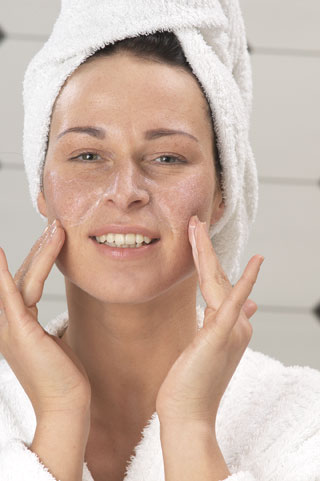
Picture:
Gesellschaft für Dermopharmazie
Preserve a young appearance: thanks to the dermopharmaceutic
research, important anti-age-active substances could be identified in the meantime.
Among them there are light protection- and humectant substances, antioxidants,
DNA repair substances and hormones. They are able to partly reverse already
arisen skin-ageing processes.
top

Picture:
Gesellschaft für Dermopharmazie
Sunglasses, headgear and textiles - this way a great part of
the sunrays harmful for skin can be prevented. At uncovered parts of skin, sun
protection products with sun protection filters and photolyasis help avoiding
the sunrays. While filters are able to protect in a preventive way, the enzyme
photolyasis can partly 'repair' skin injuries
top
Widespread Disease Mycosis Pedis: Prophylaxis and Therapy
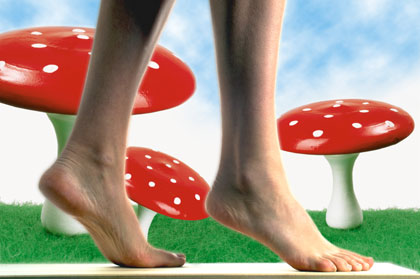
Picture:
Gesellschaft für Dermopharmazie
Widespread disease mycosis pedis: approximately 30 percent
of the population are affected. Many of them are never really healed from the
disease, due to the fact that they do not treat it correctly or not at all.
Meanwhile a cream and spray with the active substance Terbinafine is available
which safely kills the fungi in case of infestation of the toe interdigits within
seven days.
top
That
hits the Nail on the Foot!

Picture:
Gesellschaft für Dermopharmazie
Nail mycosis is a typical secondary disease of insufficiently
treated mycosis pedis, which has been considered as being incurable for a long
period of time. Thanks to Fluconazole, an active ingredient that is taken in
form of capsules, nail mycosis can now be healed by a therapy of six months'
duration.
GD
Press Conference Hamburg 2002
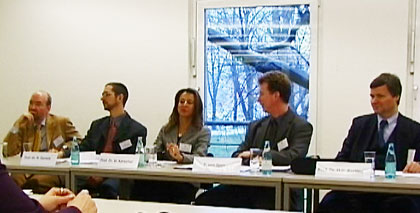
From left: Prof. Dr. med. Jean Krutmann, Prof. Dr. Rolf Daniels,
Prof. Dr. Martina Kerscher, Hamburg, Frank von Spee (moderator),
Prof. Dr. med. Hans Christian Korting
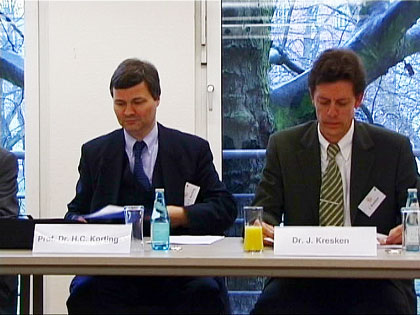
Prof. Dr. med. Hans Christian Korting, München, (left)
Dr. Joachim Kresken, Viersen (right)

Prof. Dr. med. Jean Krutmann (left) and Prof. Dr. Rolf Daniels (right)
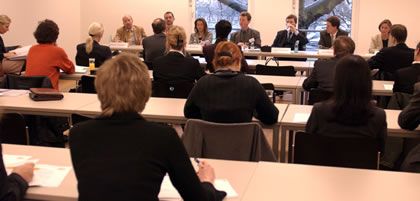

Prof. Dr. med. Martina Kerscher
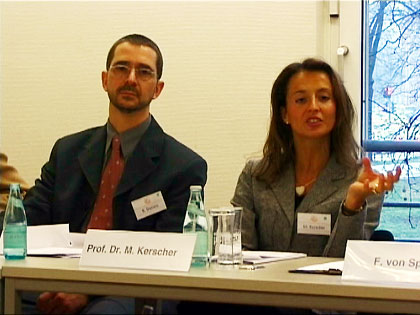
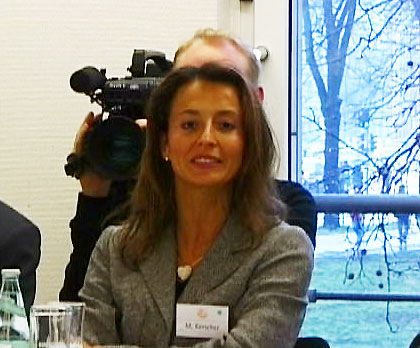
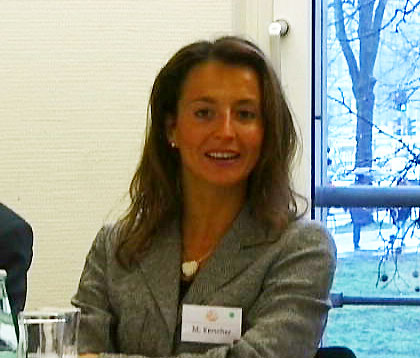
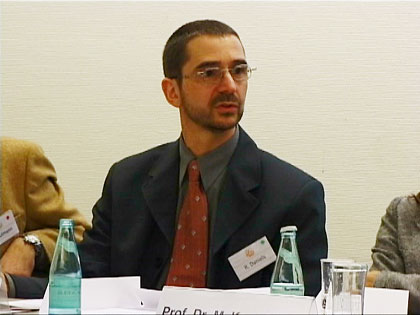

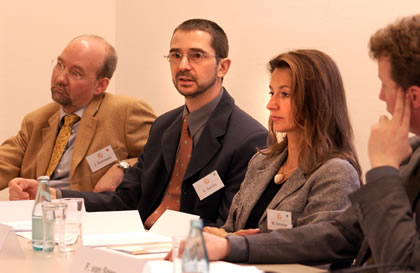
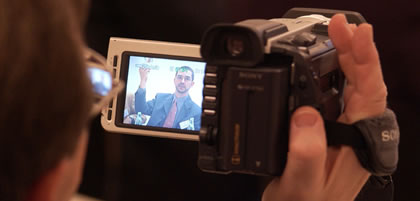
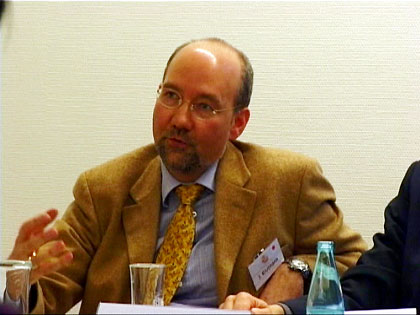


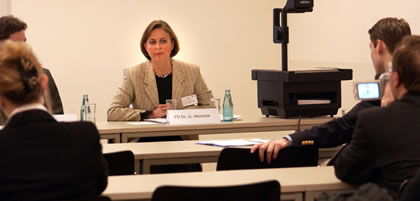


Prof. Dr. med. Hans Christian Korting


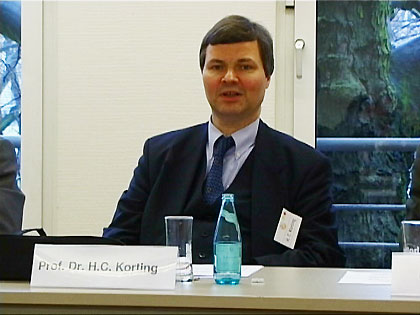

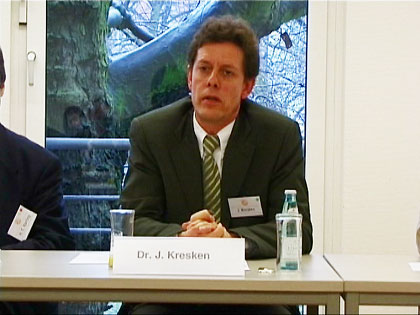
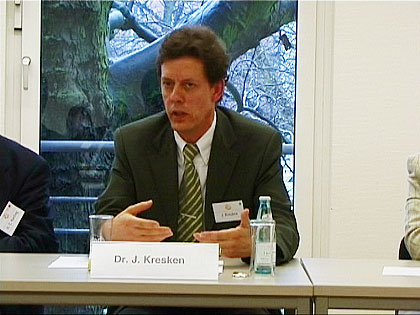
Copyright © 2000 - 2002 Institute for Dermopharmacy GmbH webmaster@gd-online.de